Photochromic lens is a lens that changes its color depending on the amount of ultraviolet rays and sunlight. It plays a role in clear glasses in places with less ultraviolet rays like indoors, and in sunglasses outdoors as photochromic lens darkens its color automatically when it is exposed to ultraviolet rays. Since you do not have to switch glasses and sunglasses, photochromic glasses are convenient for going out and outdoor activities.
Photochromic lenses are very useful items, but there is less color change during summer due to high temperatures. Let’s find more effective ways of using photochromic lens depending on seasons and scenes and understand its features by knowing mechanism of a photochromic lens and its weakness.
Weaknesses of Photochromic Lens
You might think photochromic lenses consistently change color when exposed to the same amount of ultraviolet rays. However, they have the disadvantage of not darkening easily at high temperatures as the color change of photochromic lens is highly dependent on temperature.
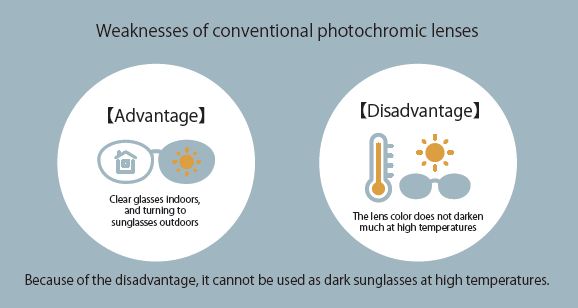
Photochromic lenses are very useful because they have the advantage of keeping the clearness indoors with fewer ultraviolet rays and lower amount of light and turning to sunglasses outdoors. On the other hand, one disadvantage is that the darkness of color when activated is unstable as it changes depending on temperature.
Photochromic glasses when activated become very dark at low temperatures, but their color does not darken enough at high temperatures, so you may not be satisfied with them as sunglasses because they cannot block glare adequately. Even though you need dark-colored sunglasses especially when the sunlight is bright in summer, this disadvantage could disappoint you.
In reality, we have a lot of opinions from customers that says, “The photochromic glasses which I bought in the cool season have not changed their color at all in summer”.
Mechanism of Not Darkening Lens Color
Why don’t photochromic lenses change color easily under high-temperature conditions?
Photochromic lenses darken when the transparent (photochromic) pigment reacts to sunlight and ultraviolet rays.
The activated pigment darkens and fades back to transparency at the same time.
The reactions of darkening color and fading of the pigment are balanced like a seesaw.
When temperature is low, the lens color remains the darkness as the speed of fading is slower than that of darkening.
In contrast, as fading happens more quickly when temperature is high, lens color does not darken enough.
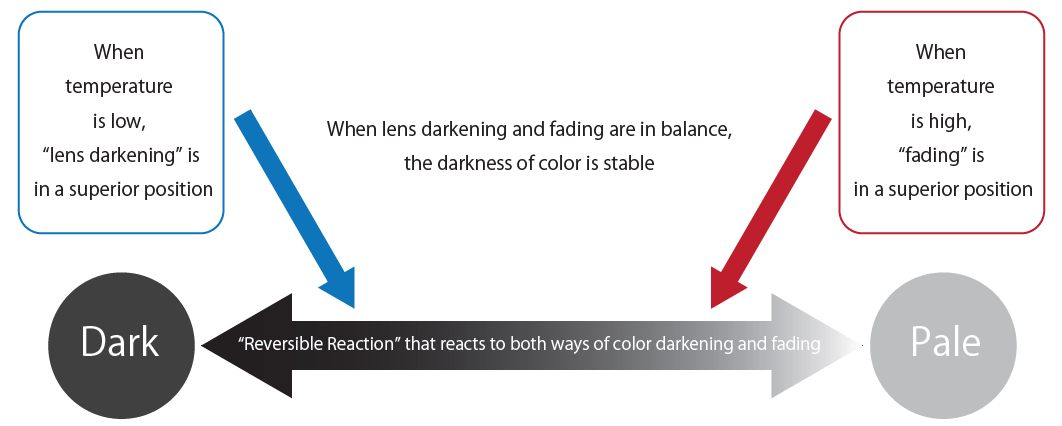
When temperature rises, the lens does not darken enough since fading is in a superior position.
When temperature falls, lens darkening is in a superior position, so the lens gets darker.
The color of photochromic lenses is stable when the reaction of “lens darkening” triggered by exposing to ultraviolet rays and the reaction of fading occurs by losing ultraviolet rays are in balance. This is called “Equilibrium”. The color of lenses changes depending on the power balance of reversible reaction trying to fade.
【High-Temperature Adaptive Lens LUTINA PHOTO V2】
The first suggestion is a new photochromic lens that is less affected by high temperatures.
〈What Is High-Temperature Adaptive Photochromic Lens?〉
One feature of “LUTINA PHOTO V2” is that this is a “high-temperature adaptive photochromic lens” that has been improved to change color darker than conventional photochromic lenses under high-temperature conditions.
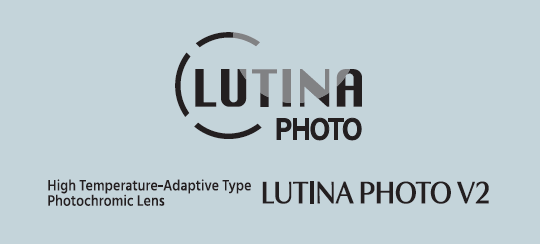
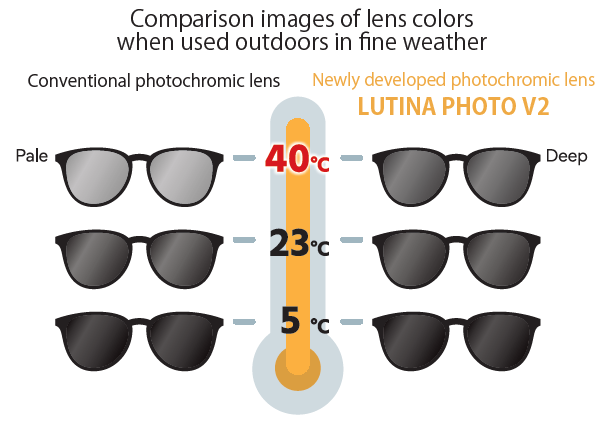
Even under high-temperature conditions at 40℃, LUTINA PHOTO V2 lens color darkens compared to conventional photochromic lenses like the image above.
Compared with visual transmittance, it has increased by approximately 10% for gray and by approximately 15% for brown.
Please watch the video below. We conducted an experiment to confirm that LUTINA PHOTO V2 darkens properly at 40℃ compared to 23℃, which is the average temperature.
You can clearly see the improvement.
People who have used photochromic glasses but were concerned that they don’t change color properly in summer, or those who avoided them because they don’t darken enough, please try LUTINA PHOTO V2.
〈Lenses for Protecting Eyes〉
The other feature of LUTINA PHOTO V2 is that this is the photochromic lens using “LUTINA” material.
LUTINA protects the pigment called “lutein” in your eyes by blocking not only ultraviolet rays but also 94% of *HEV.
*HEV…High Energy Violet light (400~420nm), HEV doesn’t represent the entire wavelength range of blue light
*In case of 1.60 refractive index, flat plate, 2mm center thickness
Additionally, LUTINA PHOTO V2 is equipped with “P-UV” for blocking 95% of ultraviolet rays reflecting on the back surface of the lenses, so it can protect your eyes from various scenes when going out.
These are the strengths of TOKAI’s photochromic lens and key features!
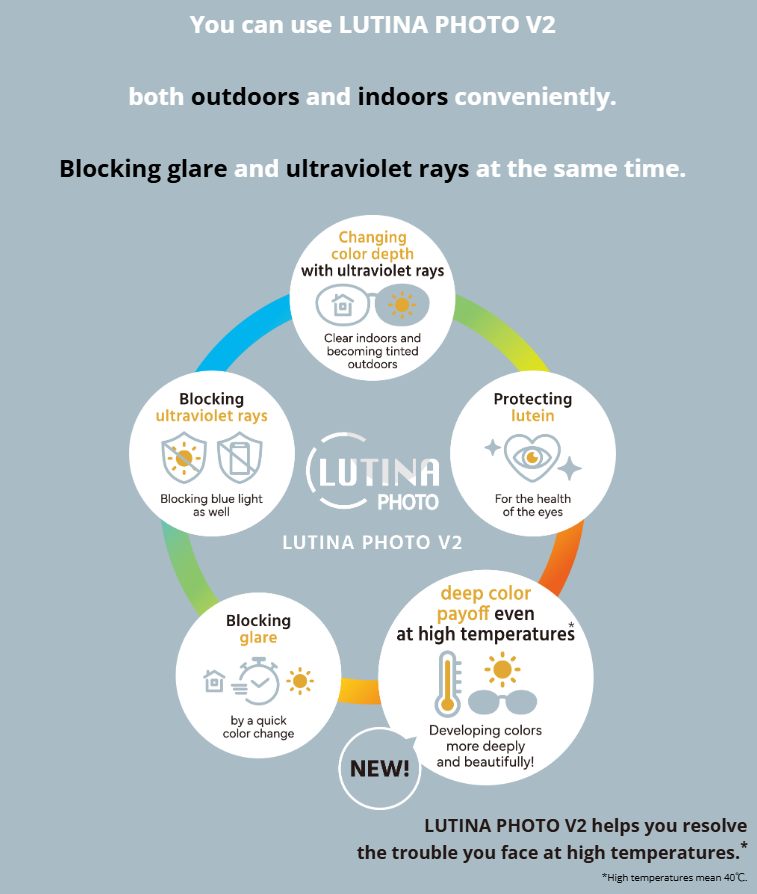
【“Transitions XTRActive New Generation” which changes its color according to visible lights】
There is a lens that darkens more than standard photochromic lenses because it responds not only to ultraviolet rays but also to visible light, increasing the number of light rays that trigger color change.
The second suggestion is “Transitions XTRActive New Generation”

Visible light photochromic lenses, which darken in response to more light rays, relatively maintain stable photochromic performance and darken at high temperatures.
This makes them convenient for use in environments like inside vehicles where ultraviolet rays are blocked.
【Own one more pair of sunglasses with dark shade】
This is the third suggestion, own one more pair of sunglasses. The most effective way to reduce glare is to have sunglasses that suit your eyes. You need to have them as the second pair of sunglasses, but they work well for people who struggle with outside glare.
【Summary】
We recommend “LUTIINA PHOTO V2” that is adaptive to high temperatures in summer as you can spend both indoor and outdoor comfortably with it. Let’s enjoy outdoor activities in hot summer with the photochromic lens which blocks glare, ultraviolet rays, and HEV at the same time while protecting eye health.
*Cautions
・All photos and illustrations contained on this page are for reference only. They might be different depending on some conditions.
・LUTINA PHOTO V2 is not available in “SB(Surf Blue)” which was compatible with the conventional LUTINA PHOTO.
“GY(Gray)” and “BR(Brown)” are still available.
・“High-Temperature Adaptive” refers to the adaptation to color change. Lens tolerance is the same as standard plastic lenses, so please do not store LUTINA PHOTO V2 in high-temperature environments like inside vehicles.

